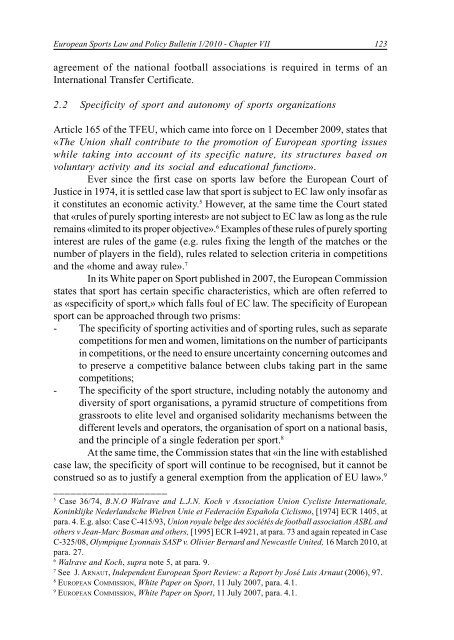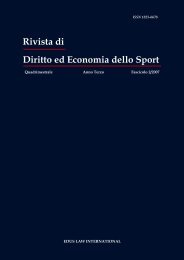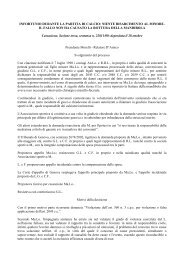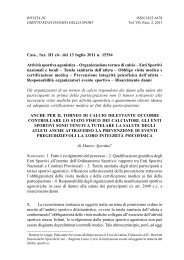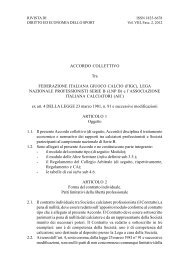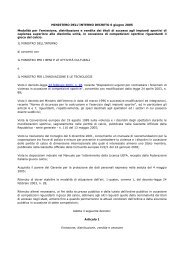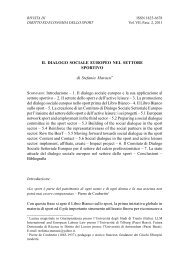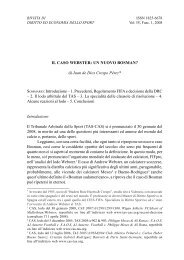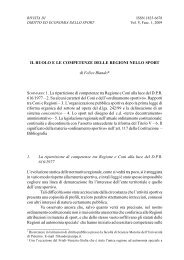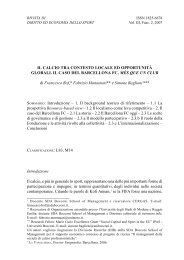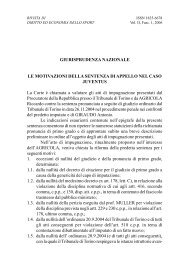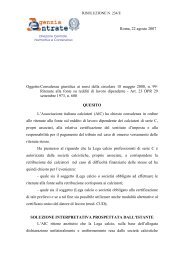European Sports Law and Policy Bulletin THE BERNARD ... - Slpc.eu
European Sports Law and Policy Bulletin THE BERNARD ... - Slpc.eu
European Sports Law and Policy Bulletin THE BERNARD ... - Slpc.eu
Create successful ePaper yourself
Turn your PDF publications into a flip-book with our unique Google optimized e-Paper software.
<strong>European</strong> <strong>Sports</strong> <strong>Law</strong> <strong>and</strong> <strong>Policy</strong> <strong>Bulletin</strong> 1/2010 - Chapter VII 123agreement of the national football associations is required in terms of anInternational Transfer Certificate.2.2 Specificity of sport <strong>and</strong> autonomy of sports organizationsArticle 165 of the TFEU, which came into force on 1 December 2009, states that«The Union shall contribute to the promotion of <strong>European</strong> sporting issueswhile taking into account of its specific nature, its structures based onvoluntary activity <strong>and</strong> its social <strong>and</strong> educational function».Ever since the first case on sports law before the <strong>European</strong> Court ofJustice in 1974, it is settled case law that sport is subject to EC law only insofar asit constitutes an economic activity. 5 However, at the same time the Court statedthat «rules of purely sporting interest» are not subject to EC law as long as the ruleremains «limited to its proper objective». 6 Examples of these rules of purely sportinginterest are rules of the game (e.g. rules fixing the length of the matches or thenumber of players in the field), rules related to selection criteria in competitions<strong>and</strong> the «home <strong>and</strong> away rule». 7In its White paper on Sport published in 2007, the <strong>European</strong> Commissionstates that sport has certain specific characteristics, which are often referred toas «specificity of sport,» which falls foul of EC law. The specificity of <strong>European</strong>sport can be approached through two prisms:- The specificity of sporting activities <strong>and</strong> of sporting rules, such as separatecompetitions for men <strong>and</strong> women, limitations on the number of participantsin competitions, or the need to ensure uncertainty concerning outcomes <strong>and</strong>to preserve a competitive balance between clubs taking part in the samecompetitions;- The specificity of the sport structure, including notably the autonomy <strong>and</strong>diversity of sport organisations, a pyramid structure of competitions fromgrassroots to elite level <strong>and</strong> organised solidarity mechanisms between thedifferent levels <strong>and</strong> operators, the organisation of sport on a national basis,<strong>and</strong> the principle of a single federation per sport. 8At the same time, the Commission states that «in the line with establishedcase law, the specificity of sport will continue to be recognised, but it cannot beconstrued so as to justify a general exemption from the application of EU law». 9____________________5Case 36/74, B.N.O Walrave <strong>and</strong> L.J.N. Koch v Association Union Cycliste Internationale,Koninklijke Nederl<strong>and</strong>sche Wielren Unie et Federación Española Ciclismo, [1974] ECR 1405, atpara. 4. E.g. also: Case C-415/93, Union royale belge des sociétés de football association ASBL <strong>and</strong>others v Jean-Marc Bosman <strong>and</strong> others, [1995] ECR I-4921, at para. 73 <strong>and</strong> again repeated in CaseC-325/08, Olympique Lyonnais SASP v. Olivier Bernard <strong>and</strong> Newcastle United, 16 March 2010, atpara. 27.6Walrave <strong>and</strong> Koch, supra note 5, at para. 9.7See J. ARNAUT, Independent <strong>European</strong> Sport Review: a Report by José Luis Arnaut (2006), 97.8EUROPEAN COMMISSION, White Paper on Sport, 11 July 2007, para. 4.1.9EUROPEAN COMMISSION, White Paper on Sport, 11 July 2007, para. 4.1.


